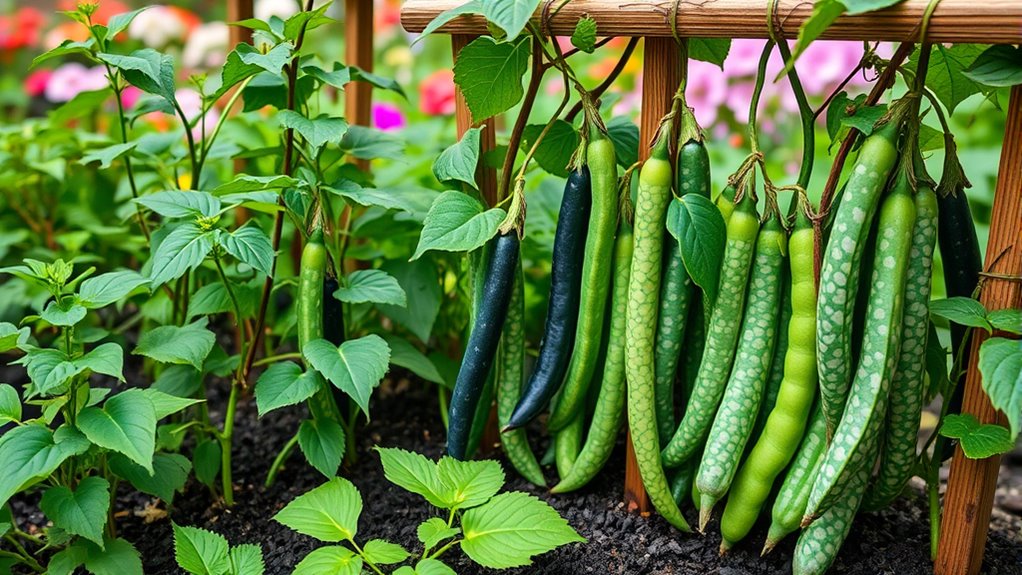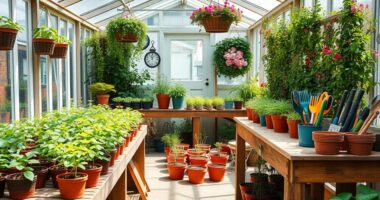If you’re looking to enhance your garden this season, I’ve found some fantastic bean varieties to contemplate. From Certified Glyphosate Residue Free Kidney Beans for quick cooking to non-GMO Pinto Beans that are easy to grow, you’ll be set for delicious dishes. Don’t overlook the nutrient-rich Henderson Lima Beans or the high-yielding Contender Bush Green Beans, either. There’s so much to explore, and there are even kits for sprouting your own beans. Let’s discover the best options together!
Key Takeaways
- Kidney Beans: Certified glyphosate residue-free, quick-cooking, and ideal for dishes like Jamaican rice and peas, perfect for home gardens.
- Pinto Beans: Non-GMO heirloom seeds that thrive in various zones, enriching soil by fixing nitrogen, excellent for chili and refried beans.
- Henderson Lima Beans: Drought-resistant and high in protein, these heirloom beans grow compactly, suitable for fresh, canned, or dried use.
- Contender Bush Green Beans: Early-maturing and high-yielding, this stringless variety retains flavor well, ideal for freezing or canning.
- Sow Right Seeds Fordhook Lima Beans: Adaptable to heat and drought, these easy-to-grow beans flourish in full sun with a 70-80 day maturity period.
Certified Glyphosate Residue Free Kidney Beans (25 lbs)
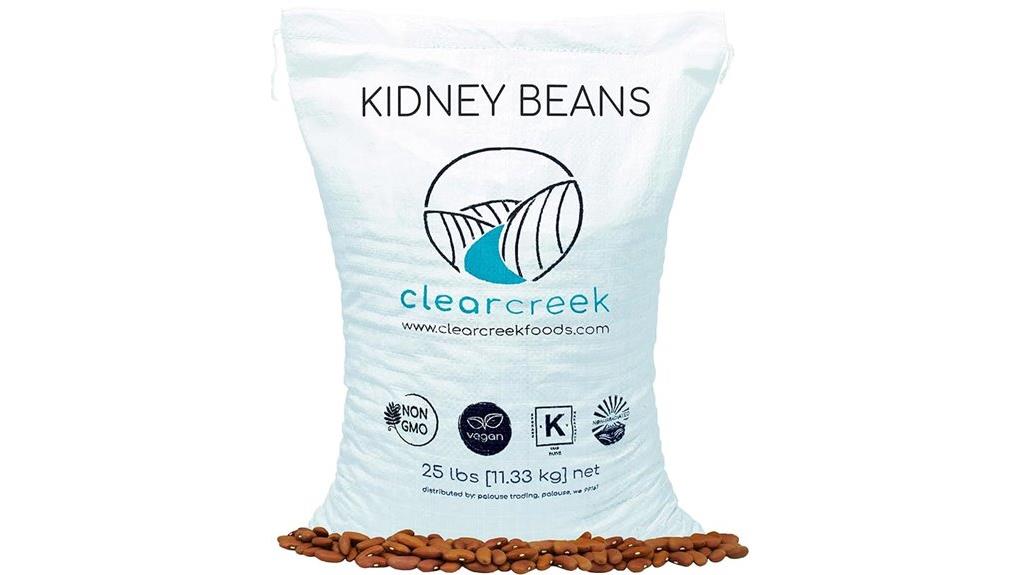
If you’re looking for a reliable and high-quality option for your garden, the Certified Glyphosate Residue Free Kidney Beans (25 lbs) stand out as an excellent choice. They’re non-GMO, vegan, and certified Kosher, ensuring you get pure, clean beans without any unwanted chemicals. Sourced from North American farmers and packaged in a HACCP certified facility, these beans promise freshness and flavor. I love that they can last decades when stored properly. Plus, their quick cooking time makes them perfect for dishes like Jamaican rice and peas. Just remember to have a container ready for repackaging to maintain their quality!
Best For: Health-conscious individuals and families looking for high-quality, chemical-free kidney beans for their cooking needs.
Pros:
- Certified Glyphosate Residue Free, ensuring no harmful chemicals in your food.
- Quick cooking time due to freshness, making meal preparation faster.
- Sourced from North American farmers, supporting local agriculture and ensuring quality.
Cons:
- Shipping bag may be difficult to open, requiring an additional container for repackaging.
- Larger quantity (25 lbs) may not be suitable for smaller households or those with limited storage space.
- Some customers may find the need for repackaging inconvenient for long-term storage.
1 Pack Pinto Bean Seeds for Planting
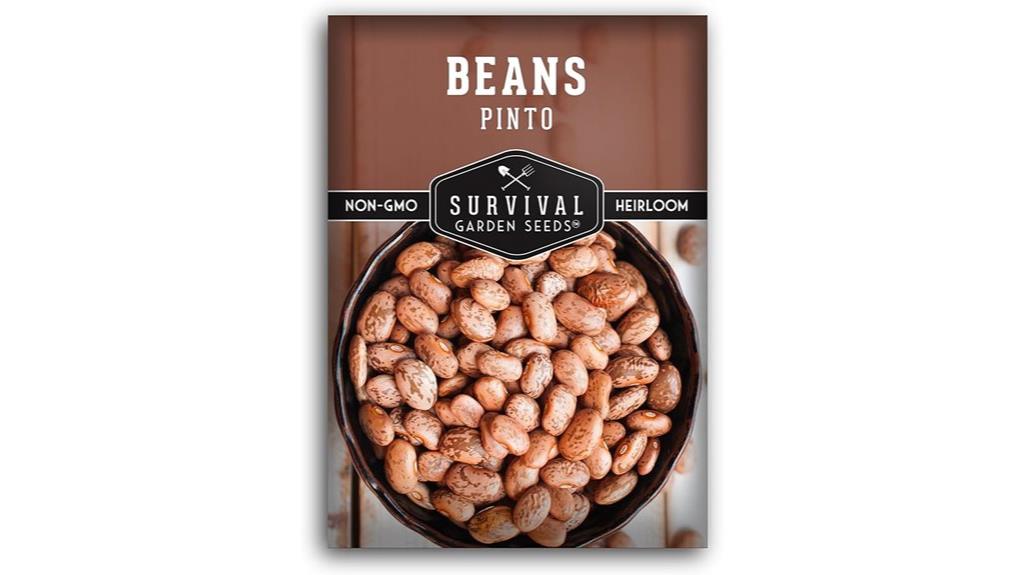
Choosing to pack Pinto bean seeds for planting is ideal for gardeners who value resilience and versatility in their crops. These non-GMO, open-pollinated heirloom seeds boast high germination rates and can last for years when stored properly. Pinto beans thrive in Zones 3-10, making them perfect for various climates. They’re drought-tolerant, easy to harvest, and enrich soil by fixing nitrogen. Plus, their speckled brown beans are a culinary delight in dishes like chili and refried beans. With clear growing instructions included, both beginners and seasoned gardeners can enjoy a bountiful, nutritious harvest while promoting sustainable living.
Best For: Gardeners seeking resilient and versatile crops that promote sustainable living and provide nutritious food options.
Pros:
- High germination rates and long viability when stored properly.
- Drought and heat tolerance make them suitable for various climates.
- Enriches soil quality by fixing nitrogen, enhancing overall garden health.
Cons:
- May require specific conditions to thrive, limiting gardening in colder zones.
- Some gardeners may find the need for additional support in harvesting and processing.
- Potential for pests or diseases if not managed properly during growth.
Survival Garden Seeds – Henderson Lima Bean Seed for Planting
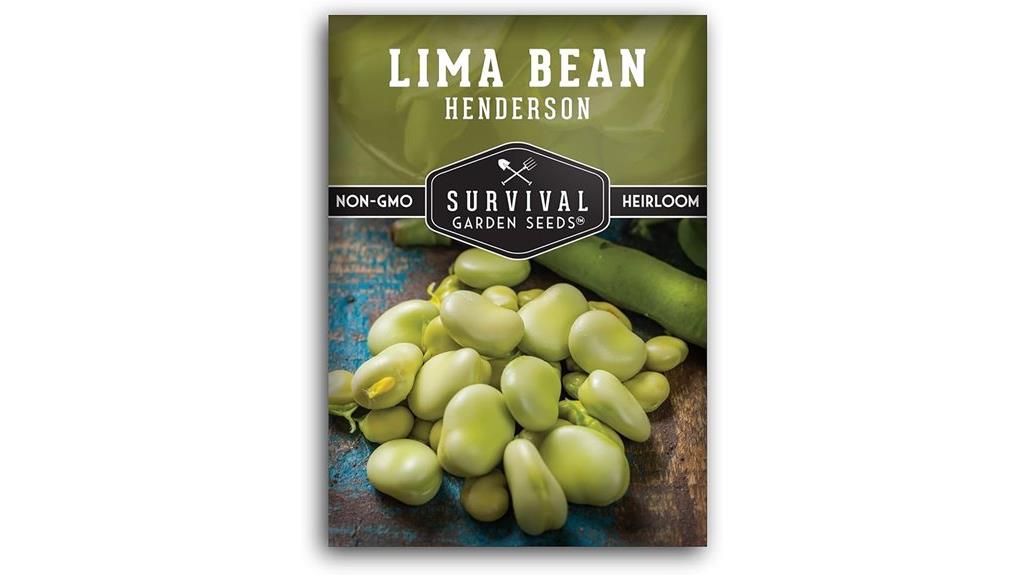
For gardeners seeking a reliable and nutritious option, the Henderson Lima Bean Seed stands out as an excellent choice. This non-GMO heirloom variety, often called white butter beans, is packed with protein and can be enjoyed fresh, canned, or dried for long-term storage. I appreciate its bush-style, compact growth, making it drought-resistant and perfect for any garden. With a quick germination process and an extensive guide for seed saving, even beginners can succeed. Plus, these seeds remain viable for years when stored properly. Trust me, you’ll love the early yield and delicious harvest from these beans!
Best For: Gardeners of all experience levels looking for a nutritious, easy-to-grow bean variety for fresh consumption or long-term storage.
Pros:
- Non-GMO heirloom variety ensures a natural growing experience and seed-saving potential.
- Drought-resistant and compact growth makes it suitable for various garden sizes and conditions.
- High protein content provides excellent nutritional value, making it a great addition to meals.
Cons:
- May require moderate watering which could be a limitation in extremely arid regions.
- Sunlight exposure needs full sun, which might not be suitable for shaded garden areas.
- Some gardeners might find the specific soil type requirement (sandy soil) limiting for their gardening setup.
Sow Right Seeds Fordhook Lima Bush Bean Seeds for Planting
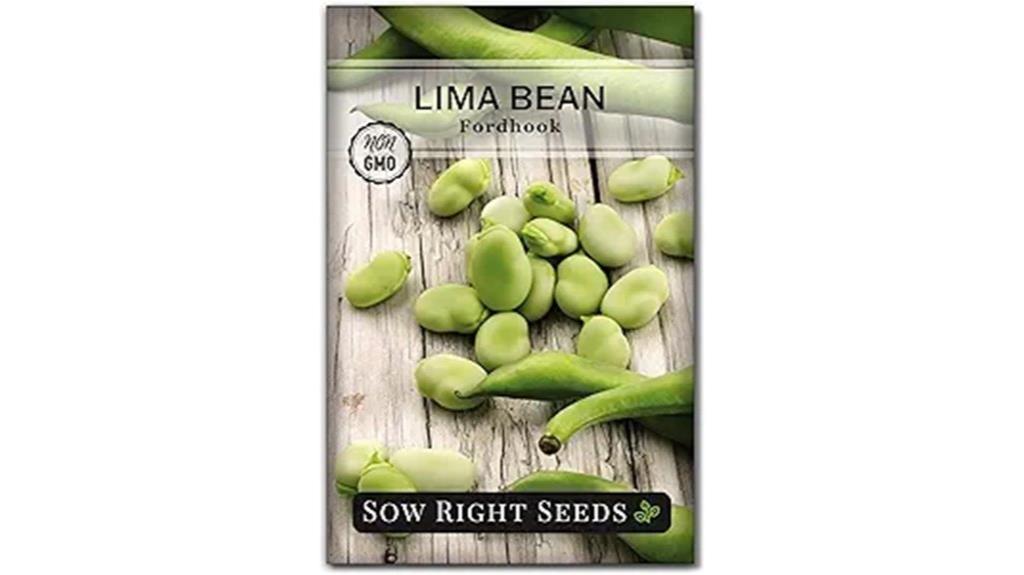
Sow Right Seeds Fordhook Lima Bush Bean Seeds stand out as the perfect choice for gardeners seeking a reliable and delicious crop. These non-GMO heirloom seeds yield plump pods filled with large, light green beans, and they adapt well to heat and drought across the U.S. I love how easy they are to grow—just plant them an inch deep, spaced 4-6 inches apart, and they’ll thrive in full sun. With a maturity of 70-80 days, I can’t wait to sauté them or toss them in casseroles. Plus, the company’s commitment to sustainability is a huge bonus!
Best For: Gardeners looking for a resilient and flavorful crop that thrives in various conditions.
Pros:
- High germination rate, with many users reporting 100% success.
- Prolific pod production, offering a bountiful harvest.
- Adaptable to both container gardens and traditional plots, making them ideal for diverse gardening setups.
Cons:
- Requires full sun exposure, which may limit planting options in shaded areas.
- Maturity takes 70-80 days, which may be longer than some gardeners prefer.
- Limited to USDA zones 3-10, potentially excluding some regions.
Sow Right Seeds Contender Bush Green Bean Seeds for Planting

If you’re looking for an early-maturing, high-yield bean variety, the Contender Bush Green Bean seeds from Sow Right Seeds are an excellent choice. These stringless beans grow 5-8 inches long and are perfect for roasting, sautéing, or snacking. I love that they retain their flavor when frozen or canned, making them versatile for various dishes. Plant them 1 inch deep in full sun, and you’ll see germination in just 7-12 days. With a maturity period of 60-75 days and a height of 12-22 inches, they fit well in any garden. Plus, the customer service is outstanding!
Best For: Home gardeners looking for an early-maturing, high-yield bean variety that is easy to grow and versatile in the kitchen.
Pros:
- High yields and early maturity, allowing for quick harvesting.
- Stringless variety that retains flavor when frozen or canned.
- Excellent customer service and commitment to quality from the company.
Cons:
- Some customers reported issues with germination rates.
- A few customers experienced delays in receiving refunds for unsatisfactory results.
- Requires full sun and specific soil temperatures for optimal growth.
Growing Beans: A Diet for Healthy People & Planet
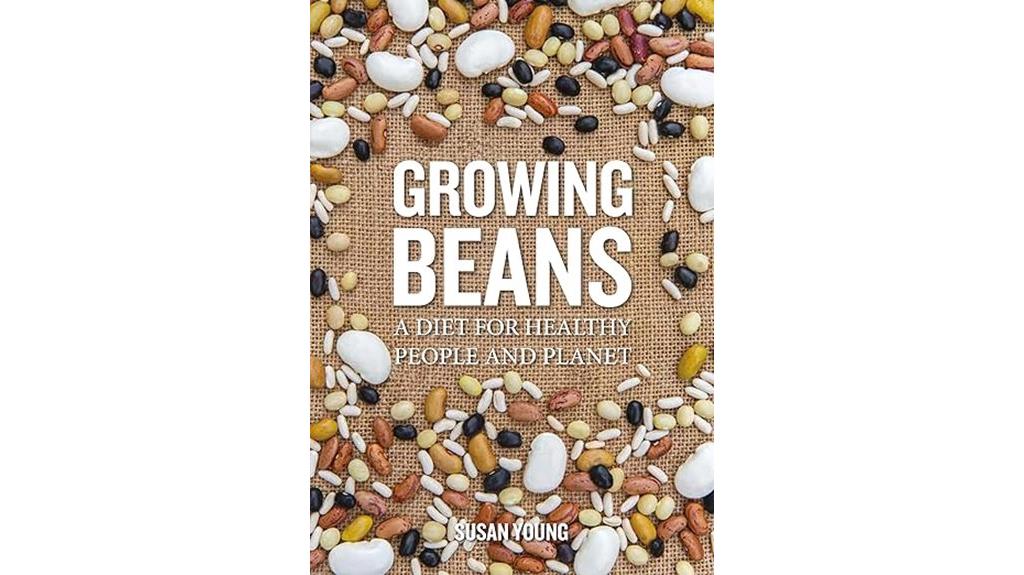
Beans stand out as a powerhouse of nutrition, making them an excellent choice for anyone looking to enhance their diet while supporting sustainability. They’re a sustainable protein source that benefits both personal health and our planet. I find that increasing bean consumption can really help tackle climate and food production challenges. Plus, the variety of beans available means there’s something for everyone! Whether you’re a novice or seasoned grower, the practical tips on cultivation, drying, and storage can make bean gardening accessible. Incorporating beans into meals is easy, and they’re a delicious way to promote a healthier lifestyle.
Best For: Individuals looking to improve their diet and support sustainable practices through the incorporation of beans.
Pros:
- Sustainable Nutrition: Beans provide a protein-rich, environmentally friendly food source.
- Practical Guidance: Offers useful tips for growing, drying, and storing beans, making it accessible for growers of all levels.
- Variety and Flavor: Introduces a wide range of bean varieties, enhancing culinary diversity and flavor in meals.
Cons:
- Limited Depth for Experts: Some experienced growers may find the information lacking in depth or advanced techniques.
- Not a Recipe Book: While it offers cooking advice, it does not provide specific recipes, which may disappoint those seeking meal ideas.
- Beginner Focus: The content may be more beneficial for novices, potentially leaving seasoned growers wanting more advanced insights.
Sow Right Seeds – Bush Henderson Lima Bean Seeds for Planting (Non-GMO Heirloom Packet)
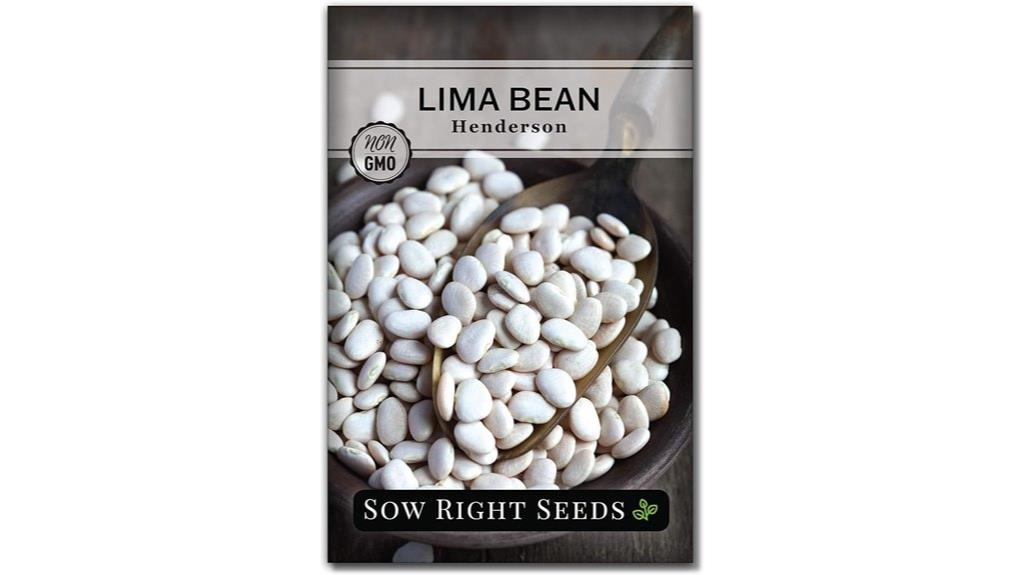
For anyone looking to cultivate a delicious and versatile addition to their garden, the Bush Henderson Lima Bean Seeds from Sow Right Seeds are a fantastic choice. These non-GMO heirloom seeds produce creamy, tender beans perfect for sautéing, casseroles, or even eating raw. I love that they grow to just 16-18 inches tall and mature in 55-65 days, making them a quick and rewarding crop. With planting instructions included, it’s super easy to get started. Plus, their sustainable, solar-powered operation guarantees I’m supporting eco-friendly practices while enjoying fresh produce. Give them a try, and you won’t be disappointed!
Best For: Gardeners and cooking enthusiasts looking for a quick-growing, non-GMO heirloom bean variety to add to their vegetable garden.
Pros:
- Easy to grow with a short maturity time of 55-65 days.
- Versatile culinary uses, suitable for various dishes such as sautéing, casseroles, or eating raw.
- Supports eco-friendly practices with a fully solar-powered operation.
Cons:
- Germination can take 7-18 days, which may be longer than some other seeds.
- Requires careful cooking to reduce cyanide content, which may deter some consumers.
- Limited to USDA Zones 3-10, which restricts growing regions.
Organic Pinto Bean Seeds – USDA Organic (1 Packet – 20 Grams)

Organic Pinto Bean Seeds are an excellent choice for home gardeners seeking a reliable and sustainable crop. These USDA-certified, non-GMO seeds come in a 20-gram packet, containing about 36 seeds. I love that they’re open-pollinated and heirloom, allowing me to save seeds for future planting. Plant them directly in rich, moist soil once temperatures hit 60°F. They grow well without trellising and are ready to harvest in about 90-110 days. Plus, pairing them with corn and squash boosts yields. With a 91% germination rate, I’m excited to see my garden flourish this season!
Best For: Home gardeners looking for a reliable, sustainable, and easy-to-grow crop.
Pros:
- USDA certified organic and non-GMO, ensuring high-quality seeds.
- High germination rate of 91%, promising strong growth potential.
- Open-pollinated and heirloom, allowing for seed saving for future planting.
Cons:
- Some seeds may be smaller or marred, affecting appearance.
- Requires direct sowing in specific soil conditions, which may be challenging for beginners.
- Harvesting time can be lengthy, taking up to 110 days for dried beans.
Creativity for Kids Magic Bean Garden – Arts and Crafts for Kids

If you’re looking for a fun and educational activity for kids aged 5-8, the Creativity for Kids Magic Bean Garden is an excellent choice. This kit includes everything needed to create a magical garden: non-toxic paints, a planter, potting mix, and three special magic beans. Kids can personalize their pots while learning about plant lifecycles, as these quick-growing Sword Beans sprout in just a week! It’s a perfect blend of arts and crafts that encourages creativity and responsibility. Plus, it makes a unique gift that sparks imaginative exploration, keeping kids engaged without screens.
Best For: The Creativity for Kids Magic Bean Garden is best for children aged 5-8 who enjoy hands-on activities that combine gardening and arts and crafts.
Pros:
- Encourages creativity and artistic expression through painting and decorating the planter.
- Provides an educational experience about plant lifecycles, fostering responsibility and nurturing skills.
- Quick-growing beans allow for immediate gratification and engagement in gardening activities.
Cons:
- Some users reported issues with the growth of the beans, which may lead to disappointment.
- The plastic planter’s paint adherence may not meet all customers’ expectations.
- Limited to a specific age range, which may not appeal to older children looking for more complex activities.
4-Tier Seed Sprouting Kit for Organic Microgreens

Looking to grow fresh microgreens right at home? I absolutely love the 4-Tier Seed Sprouting Kit for Organic Microgreens. Its corrugated design keeps seeds in place and drains excess water effectively. The stackable, ventilated trays save space while enhancing humidity, allowing sprouts to flourish. Made from durable, food-grade materials, it’s perfect for novice and expert gardeners alike—no soil needed! I appreciate how easy it is to clean and maintain. Plus, the kit can handle a variety of seeds, including bean sprouts. With first sprouts popping up in just about four days, it’s a game-changer for my gardening routine!
Best For: This product is best for both novice and expert gardeners looking to grow fresh microgreens quickly and easily at home.
Pros:
- Simple and efficient design allows for fast seed germination without the need for soil.
- Stackable, ventilated trays save space and help maintain optimal humidity levels for sprouting.
- Made from durable, food-grade materials that are easy to clean and reusable.
Cons:
- Some users report clogging issues when using very small seeds.
- Suggestions for improvement include larger drainage holes for better water flow.
- Taller trays might be needed to prevent mold and accommodate taller sprouts.
Islas Garden Heirloom Bean Seeds (Borlotti Bean)
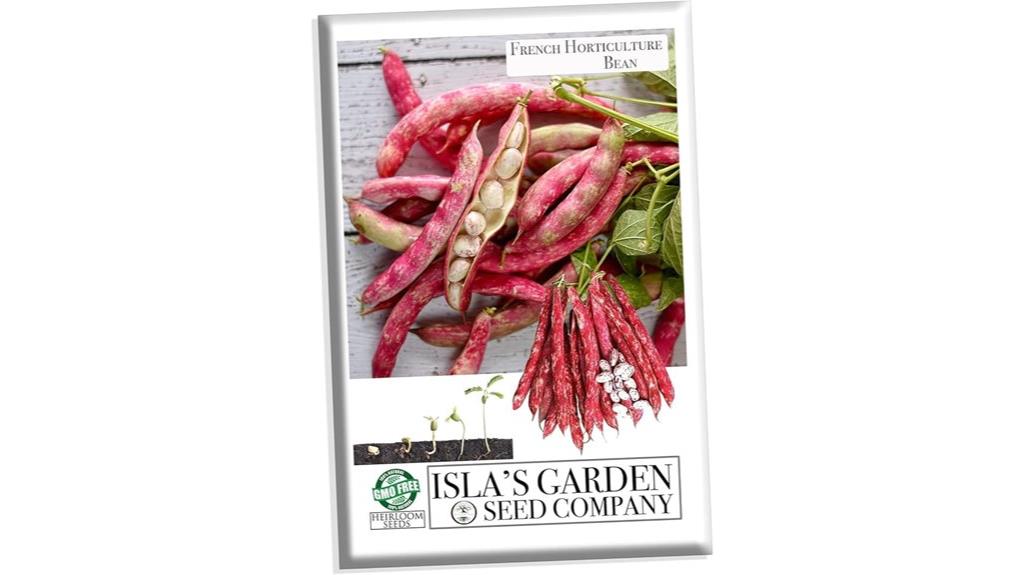
For gardeners seeking a flavorful and visually appealing addition to their plots, Islas Garden Heirloom Bean Seeds (Borlotti Bean) stand out as an excellent choice. These non-GMO, annual beans mature in about 68-70 days and reach a height of 24 inches. I love their flat, 8-inch green pods that turn yellow with red splashes when dried. With moderate watering and full sun, they flourish in USDA Hardiness Zones 3-10. Plus, the purple seeds are perfect for soups! Customers rave about their successful growth and flavor, making them a delightful gift for any home garden enthusiast.
Best For: Home gardeners looking for a flavorful and visually appealing bean variety that thrives in various climates.
Pros:
- Non-GMO and heirloom seeds ensure a natural growing experience.
- Great flavor and versatility in culinary uses, especially in soups.
- Adaptable growth conditions suitable for a wide range of USDA Hardiness Zones (3-10).
Cons:
- Moderate watering requirements may be a consideration for less experienced gardeners.
- Growth height of 24 inches might require support in windy areas.
- Longer maturity time of 68-70 days compared to some other bean varieties.
Complete Sprouting Kit with Mason Jars and Accessories
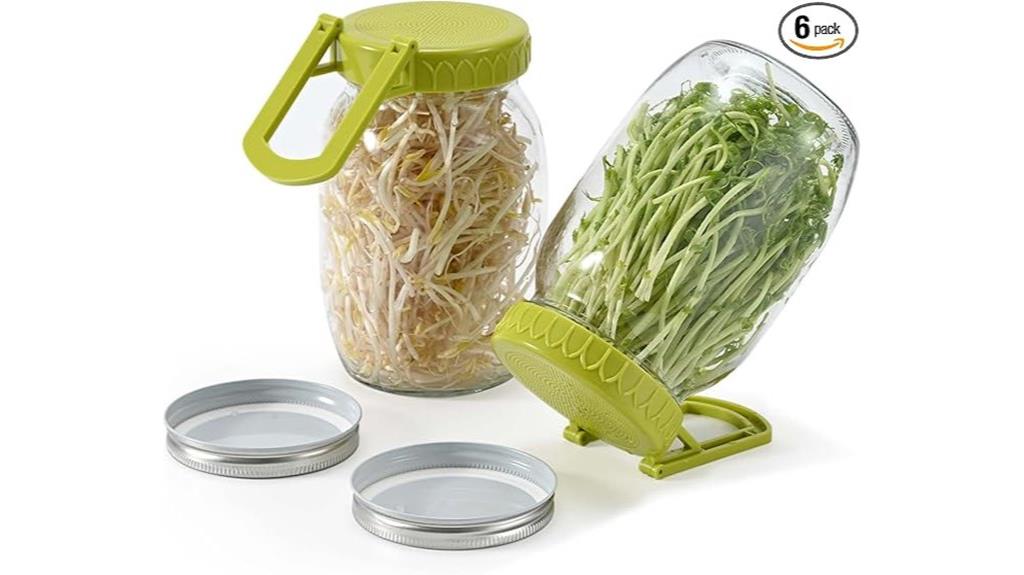
The Complete Sprouting Kit with Mason Jars and Accessories is perfect for anyone enthusiastic to cultivate their own beans and other nutritious sprouts at home. This kit includes two large wide-mouth Mason jars, which make it easy to access and clean your sprouts. The foldable screen lids guarantee proper airflow, while the 45-degree stand helps with draining. Made from food-grade materials, these jars are safe and durable. I appreciate the versatility; they can also be used for drinks or decorative purposes. While some users suggest sturdier glass, I find the kit functional and easy to use for sprouting delicious beans.
Best For: Home enthusiasts looking to grow their own nutritious sprouts easily and safely.
Pros:
- Versatile usage for sprouting as well as serving beverages and decorative purposes.
- Wide-mouth jars allow for easy access and cleaning, promoting healthy sprout growth.
- Foldable screen lids and a draining stand enhance airflow and efficiency during the sprouting process.
Cons:
- Some users reported the glass jars to be of lower quality, suggesting thicker alternatives.
- Uniformity in jar size is lacking, making sprout removal more challenging for some.
- Mixed reviews on overall durability, with concerns about the longevity of the materials used.
Premium Sprouts Growing Kit & Green Onion Regrower
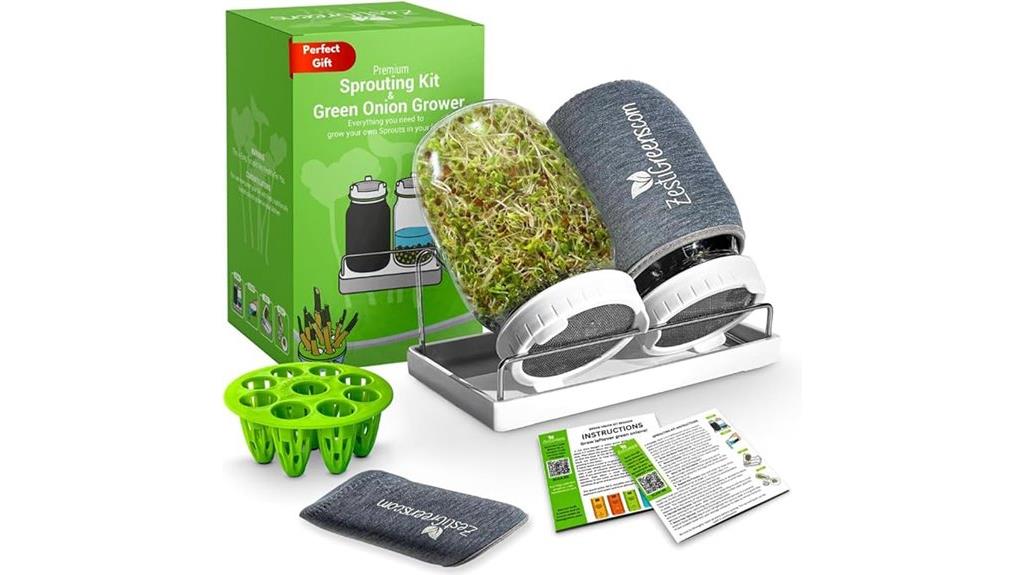
If you’re enthusiastic to grow your own nutritious greens at home, the Premium Sprouts Growing Kit & Green Onion Regrower is an excellent choice. This kit includes everything you need: two large Mason jars, superior sprout lids, and a unique green onion regrower lid. I love how easy it is to sprout broccoli, alfalfa, and beans right in my kitchen. Plus, the hydroponic system lets me regrow leftover green onions effortlessly. With a 4.6-star rating from users, it’s perfect for beginners or as a thoughtful gift. Enjoy enhancing your meals with fresh greens while nurturing a fun new hobby!
Best For: Beginners looking to grow nutritious greens at home and those interested in a fun and rewarding hobby.
Pros:
- Easy to use, making home sprouting accessible for everyone.
- Includes a unique green onion regrower to maximize kitchen produce.
- High customer satisfaction with a rating of 4.6 out of 5 stars.
Cons:
- Some users reported chemical smells from the blackout sleeves.
- Seeds are not included, requiring additional purchases for sprouting.
- Limited to specific types of sprouts and greens.
Nature Jims Premium Mung Bean Sprouting Seeds (16 Oz)
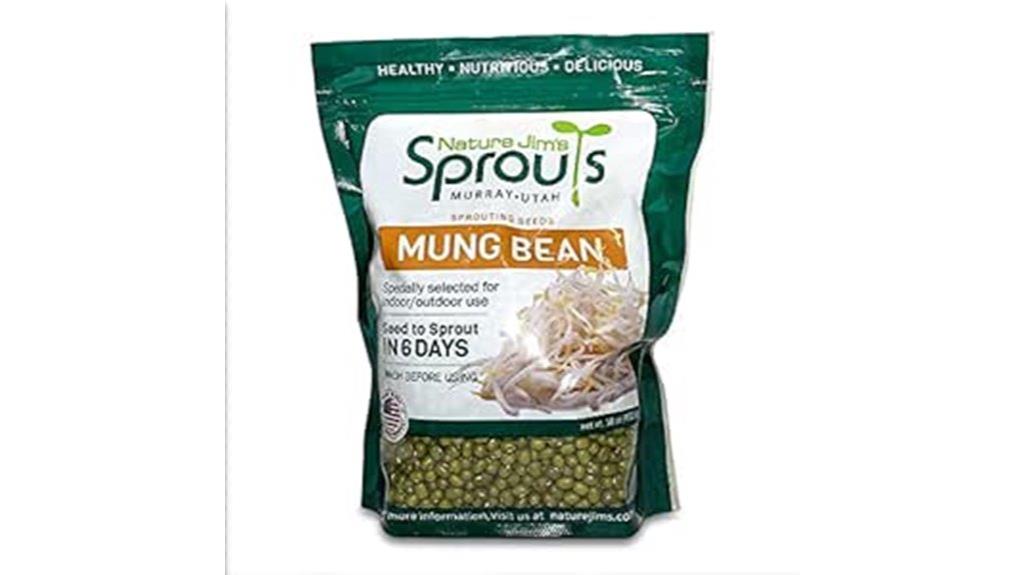
Nature Jim’s Premium Mung Bean Sprouting Seeds stand out as an ideal choice for home gardeners and health enthusiasts alike. These non-GMO seeds come in a resealable 16 oz bag, ensuring freshness and flavor with safe-seal technology. Mung beans are a superfood, packed with vitamins, minerals, and protein, helping lower bad cholesterol and boost immunity. Growing them is simple: just soak, drain, and rinse a few times daily for 3-4 days. Each crop can yield about 1 pound of delicious sprouts, and with high germination rates, you’ll enjoy fresh, home-grown nutrition that’s hard to beat!
Best For: Home gardeners and health enthusiasts looking for fresh, nutritious sprouts.
Pros:
- High germination rates (up to 100%) for reliable growth.
- Easy to grow with clear instructions for beginners.
- Rich in vitamins, minerals, and protein, making them a healthy addition to meals.
Cons:
- Requires daily rinsing for optimal growth, which may be time-consuming.
- Limited shelf life once the bag is opened, despite resealable packaging.
- Initial setup may deter those unfamiliar with sprouting seeds.
Factors to Consider When Choosing Bean Growing

When I choose beans to grow, I always think about a few key factors that can make or break my garden. It’s not just about picking a seed variety; I also consider soil quality, sunlight exposure, and how often I need to water. Plus, I can’t forget about managing pests and diseases to guarantee a healthy crop.
Seed Variety Selection
How can you choose the best bean variety for your garden? Start by selecting non-GMO and heirloom varieties like pinto or lima beans. These options not only offer a diverse gene pool but also enhance resilience against pests and diseases. Next, consider the growth duration; for example, Fordhook lima beans mature in 70-80 days. Check for high germination rates—organic pinto beans often report around 91%. It’s also essential to assess how well the bean varieties adapt to your local climate, particularly your USDA hardiness zone. Finally, think about your culinary preferences. Beans like Borlotti are favored for their exceptional flavor in soups and stews, making them a delightful choice for your garden.
Soil Quality Importance
Soil quality plays an important role in the success of your bean garden. I’ve found that the ideal soil should be loamy, well-drained, and rich in organic matter. This combination promotes healthy root development and effective nutrient uptake. Aim for a pH level between 6.0 and 7.5, as this range guarantees that essential nutrients are accessible to your plants. It’s vital to maintain moderate soil moisture; overly saturated conditions can lead to root rot and stunted growth. I also recommend incorporating nitrogen-fixing cover crops to enrich the soil with nitrogen, benefiting your bean crops. Finally, regular soil testing can help you determine nutrient levels and necessary amendments to keep your growing conditions at their best.
Sunlight Exposure Requirements
To guarantee your bean plants thrive, it’s vital to choose a location that gets plenty of sunlight. Most bean varieties require full sun exposure, meaning they need at least 6-8 hours of direct sunlight each day for ideal growth. Without sufficient sunlight, you’ll likely see leggy plants, reduced flowering, and lower yields. Beans love warm conditions, and full sun helps maintain soil temperature, essential for germination. For bush varieties, adequate sunlight promotes compact growth, while pole varieties benefit from sunlight for climbing and overall health. It’s especially important to monitor sunlight exposure in areas with variable climates, as shade from nearby structures or trees can greatly impact your bean production. So, pick your spot wisely!
Watering Techniques and Frequency
While many factors influence the success of your bean garden, understanding the right watering techniques and frequency is crucial. Beans thrive with consistent moisture, so I aim to keep the soil moist but never waterlogged to prevent root rot. Typically, beans need about an inch of water per week, which I increase during hot, dry spells. Early in the growing season, I guarantee the soil stays consistently moist for proper germination. Once established, beans can handle brief dry periods. I find that using drip irrigation effectively delivers water directly to the roots, minimizing waste and reducing leaf wetness. Of course, I always check the soil moisture level and adjust my watering accordingly to support healthy growth and yield.
Pest and Disease Management
When I choose which bean varieties to grow, I always consider pest and disease management as an essential factor. Implementing crop rotation helps me reduce the buildup of pests and diseases since different plants attract various insects. I make it a habit to inspect my plants regularly for early signs of trouble, like holes in leaves or discolored spots, so I can intervene promptly. Companion planting is another strategy I love; garlic and marigolds deter harmful insects and create a healthier environment. I also focus on maintaining soil health with organic amendments, as robust plants are less prone to infections. Finally, I introduce beneficial insects like ladybugs and lacewings to naturally control common pests like aphids.
Planting Time Considerations
Understanding the right time to plant beans is essential for a successful harvest. I’ve learned that beans thrive when soil temperatures hit at least 60°F, promoting optimal germination. It’s important to note the frost dates in your area since many bean varieties are sensitive to frost. I usually plant them after the last frost date in spring. The ideal window for planting generally spans from late spring to early summer, depending on my local climate. I prefer to direct sow beans about 1 inch deep, ensuring proper spacing for healthy growth. Regularly checking soil moisture during the early stages is critical, as consistent moisture is key for successful germination and establishment. Happy planting!
Companion Planting Benefits
After getting your beans planted, considering companion planting can greatly enhance your garden’s productivity. Beans are fantastic at fixing nitrogen, improving soil health for neighboring plants. I love using the “Three Sisters” method by pairing beans with corn and squash; together, they create a thriving ecosystem. Herbs like basil and mint are also great companions, as they help deter pests, cutting down on chemical pesticide use. Planting marigolds nearby attracts beneficial insects that feast on common pests, boosting overall plant health. Plus, I rotate my bean crops with other plants to prevent soil depletion and minimize disease risks. Embracing these companion planting strategies can lead to a more vibrant, sustainable garden.
Harvesting and Storage Tips
As I prepare to harvest my bean crops, I focus on a few key factors to guarantee I get the best flavor and quality. I typically wait until the pods are firm and dry, which usually takes 50 to 110 days, depending on the variety. For dried beans, I like to shake the pods; if they rattle, they’re ready. Once harvested, I store the beans in a cool, dry place, using air-tight containers or vacuum-sealed bags to keep them fresh. Properly stored beans can last several years, and some varieties even last decades! I also make it a point to check for moisture or pests regularly and rotate my stock, ensuring I use the older beans first.
Frequently Asked Questions
What Are the Best Planting Conditions for Beans?
When I plant beans, I always make sure the soil’s well-drained and rich in organic matter. I prefer temperatures between 70 and 90°F for ideal growth, and I usually wait until the last frost has passed to sow my seeds. Beans love full sun, so I choose a spot that gets at least six hours of sunlight daily. Keeping the soil consistently moist helps too, but I avoid overwatering to prevent rot.
How Long Does It Take for Beans to Mature?
When I grow beans, I usually find that they take about 50 to 100 days to mature, depending on the variety. I’ve noticed that factors like temperature and soil conditions can influence this timeline. Warmer weather tends to speed things up, while cooler temperatures may slow them down. I always keep an eye on the plants as they grow, enthusiastic to see those lovely pods ready for harvest!
Can Beans Be Grown in Containers?
Absolutely, beans can thrive in containers, just like they do in traditional garden beds. I’ve found that using deep pots allows for healthy root growth, which is essential. When I choose varieties like bush beans, they flourish without needing a lot of space. Plus, container gardening makes it easier to control soil quality and moisture. So, if you’re tight on space, don’t hesitate to give container beans a try—you won’t regret it!
What Pests Should I Watch Out for When Growing Beans?
When I grow beans, I always keep an eye out for a few pesky pests. Aphids are a common nuisance, sucking sap and weakening plants. I’ve also encountered spider mites, which can cause leaf discoloration. Don’t forget about the bean beetle; their larvae can munch away at your crops. I recommend checking your plants regularly and using organic solutions to keep these pests at bay. Happy gardening!
How Often Should I Water My Bean Plants?
I usually water my bean plants deeply about once a week, but I keep an eye on the weather. If it’s particularly hot or dry, I’ll check the soil more frequently. I’ve found that beans prefer consistent moisture, so I try to avoid letting the soil completely dry out. Always guarantee there’s good drainage, too, to prevent any root rot. Your plants will thrive with a bit of attention!
Conclusion
In my garden journey, I’ve discovered that choosing the right bean variety can be nothing short of life-altering! With the perfect seeds, I’m convinced I could grow a veritable jungle of beans that could feed an army—or at least my family for a month! So, don’t underestimate the power of these humble legumes. Immerse yourself in the world of beans this season, and I promise you’ll harvest not just vegetables, but joy, adventure, and perhaps even a little magic!
